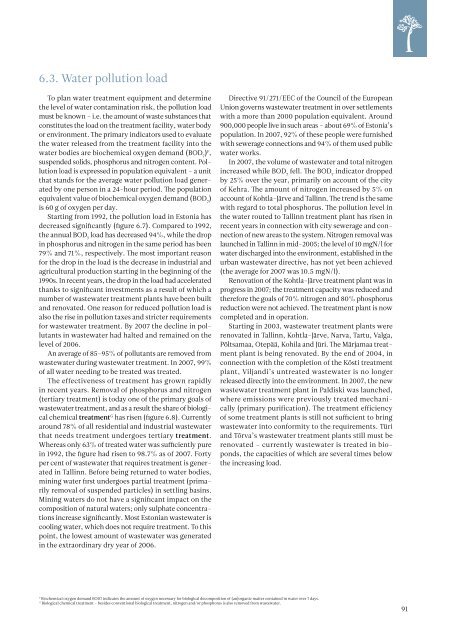ESTONIAN ENVIRONMENTAL REVIEW 2009
ESTONIAN ENVIRONMENTAL REVIEW 2009
ESTONIAN ENVIRONMENTAL REVIEW 2009
Create successful ePaper yourself
Turn your PDF publications into a flip-book with our unique Google optimized e-Paper software.
6.3. Water pollution load<br />
To plan water treatment equipment and determine<br />
the level of water contamination risk, the pollution load<br />
must be known – i.e. the amount of waste substances that<br />
constitutes the load on the treatment facility, water body<br />
or environment. The primary indicators used to evaluate<br />
the water released from the treatment facility into the<br />
water bodies are biochemical oxygen demand (BOD 7<br />
) F ,<br />
suspended solids, phosphorus and nitrogen content. Pollution<br />
load is expressed in population equivalent – a unit<br />
that stands for the average water pollution load generated<br />
by one person in a 24-hour period. The population<br />
equivalent value of biochemical oxygen demand (BOD 7<br />
)<br />
is 60 g of oxygen per day.<br />
Starting from 1992, the pollution load in Estonia has<br />
decreased significantly (figure 6.7). Compared to 1992,<br />
the annual BOD 7<br />
load has decreased 94%, while the drop<br />
in phosphorus and nitrogen in the same period has been<br />
79% and 71%, respectively. The most important reason<br />
for the drop in the load is the decrease in industrial and<br />
agricultural production starting in the beginning of the<br />
1990s. In recent years, the drop in the load had accelerated<br />
thanks to significant investments as a result of which a<br />
number of wastewater treatment plants have been built<br />
and renovated. One reason for reduced pollution load is<br />
also the rise in pollution taxes and stricter requirements<br />
for wastewater treatment. By 2007 the decline in pollutants<br />
in wastewater had halted and remained on the<br />
level of 2006.<br />
An average of 85–95% of pollutants are removed from<br />
wastewater during wastewater treatment. In 2007, 99%<br />
of all water needing to be treated was treated.<br />
The effectiveness of treatment has grown rapidly<br />
in recent years. Removal of phosphorus and nitrogen<br />
(tertiary treatment) is today one of the primary goals of<br />
wastewater treatment, and as a result the share of biological<br />
chemical treatment G has risen (figure 6.8). Currently<br />
around 78% of all residential and industrial wastewater<br />
that needs treatment undergoes tertiary treatment.<br />
Whereas only 63% of treated water was sufficiently pure<br />
in 1992, the figure had risen to 98.7% as of 2007. Forty<br />
per cent of wastewater that requires treatment is generated<br />
in Tallinn. Before being returned to water bodies,<br />
mining water first undergoes partial treatment (primarily<br />
removal of suspended particles) in settling basins.<br />
Mining waters do not have a significant impact on the<br />
composition of natural waters; only sulphate concentrations<br />
increase significantly. Most Estonian wastewater is<br />
cooling water, which does not require treatment. To this<br />
point, the lowest amount of wastewater was generated<br />
in the extraordinary dry year of 2006.<br />
Directive 91/271/EEC of the Council of the European<br />
Union governs wastewater treatment in over settlements<br />
with a more than 2000 population equivalent. Around<br />
900,000 people live in such areas – about 69% of Estonia’s<br />
population. In 2007, 92% of these people were furnished<br />
with sewerage connections and 94% of them used public<br />
water works.<br />
In 2007, the volume of wastewater and total nitrogen<br />
increased while BOD 7<br />
fell. The BOD 7<br />
indicator dropped<br />
by 25% over the year, primarily on account of the city<br />
of Kehra. The amount of nitrogen increased by 5% on<br />
account of Kohtla-Järve and Tallinn. The trend is the same<br />
with regard to total phosphorus. The pollution level in<br />
the water routed to Tallinn treatment plant has risen in<br />
recent years in connection with city sewerage and connection<br />
of new areas to the system. Nitrogen removal was<br />
launched in Tallinn in mid-2005; the level of 10 mgN/l for<br />
water discharged into the environment, established in the<br />
urban wastewater directive, has not yet been achieved<br />
(the average for 2007 was 10.5 mgN/l).<br />
Renovation of the Kohtla-Järve treatment plant was in<br />
progress in 2007; the treatment capacity was reduced and<br />
therefore the goals of 70% nitrogen and 80% phosphorus<br />
reduction were not achieved. The treatment plant is now<br />
completed and in operation.<br />
Starting in 2003, wastewater treatment plants were<br />
renovated in Tallinn, Kohtla-Järve, Narva, Tartu, Valga,<br />
Põltsamaa, Otepää, Kohila and Jüri. The Märjamaa treatment<br />
plant is being renovated. By the end of 2004, in<br />
connection with the completion of the Kösti treatment<br />
plant, Viljandi’s untreated wastewater is no longer<br />
released directly into the environment. In 2007, the new<br />
wastewater treatment plant in Paldiski was launched,<br />
where emissions were previously treated mechanically<br />
(primary purification). The treatment efficiency<br />
of some treatment plants is still not sufficient to bring<br />
wastewater into conformity to the requirements. Türi<br />
and Tõrva’s wastewater treatment plants still must be<br />
renovated – currently wastewater is treated in bioponds,<br />
the capacities of which are several times below<br />
the increasing load.<br />
F<br />
Biochemical oxygen demand BOD7 indicates the amount of oxygen necessary for biological decomposition of (an)organic matter contained in water over 7 days.<br />
G<br />
Biological chemical treatment – besides conventional biological treatment, nitrogen and/or phosphorus is also removed from wastewater.<br />
91

















